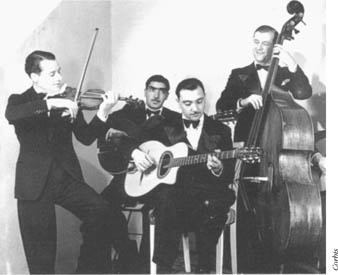Stéphane Grappelli (violin) and Django Reinhardt leading the Quintette du Hot Club de France in Paris.

Django Reinhardt was an innovative virtuoso on the guitar and, to this day, the group he led with Stéphane Grappelli remains a legend in European jazz.
Born in Liverchies, near Charleroi, Belgium, on January 3, 1910, Jean Baptiste Reinhardt was the son of a travelling Gypsy entertainer. By age 12, he began playing with local bands at dances and bars, and then moved on to solo engagements in the cafés of Montmartre in Paris. At 18, a fire in his caravan left him without the use of the last two fingers on his left hand. He had to retrain himself on the guitar, but was soon able to play the most intricate progressions with unprecedented sophistication. He bent and stretched notes to make the guitar sound like a singing voice, and played incredibly fast solos in a style partly derived from his Gypsy ancestry.
Inspired by the music of Louis ARMSTRONG and guitarist Eddie Lang, Reinhardt made his first recordings in 1934 with the Michael Warlop Orchestra, and played with French violinist Stéphane Grappelli in Louis Vola’s band. Reinhardt and Grappelli soon split from the group to form their famous all-string ensemble, the Quintette du Hot Club de France. Their premiere at Paris’s Hot Club was followed by a performance with Coleman HAWKINS, and performances with other visiting Americans (Benny CARTER, Eddie South, and others), each of which brought them greater international acclaim. By the time the quintet disbanded in 1939, the group had recorded over 200 tunes and had become the first non-Americans to make a significant impact on the development of jazz.
Stéphane Grappelli (violin) and Django Reinhardt leading the Quintette du Hot Club de France in Paris.

During World War II, Reinhardt recorded with the Air Transport Command for broadcast on the American Forces Network. He then formed another quintet, with clarinetist Hubert Rostaing, and began composing original music, including the famous “Nuages,” his own “Bolero,” and even a symphony, parts of which were used in the 1946 film Le Village de la Colère. Reinhardt’s trip to the United States in 1946, to perform with the Duke ELLINGTON Orchestra, met with mixed results. He was struggling for the first time with the electrified guitar, and was eager to conform to the new concepts of jazz created by the bebop style. He was exposed to bebop as it was being developed by Dizzy GILLESPIE, Charlie PARKER, and others, and to the electric guitar playing of Charlie CHRISTIAN, which had a profound influence on his music.
Back in Paris, Reinhardt temporarily reformed the Hot Club with Grappelli in a more informal setting. He toured Europe with his small ensemble, recorded with trumpeter Rex Stewart’s band in 1947, and in 1949 reunited with Grappelli to make their final recordings together. Reinhardt died at age 43 in May 1953, after suffering a stroke. More than 40 years after his death, he remains a seminal figure and his recordings are greatly sought after.
Todd Denton
SEE ALSO:
EUROPEAN JAZZ; GYPSY MUSIC; JAZZ.
FURTHER READING
Delaunay, Charles, trans. Michael James. Django Reinhardt (Gateshead: Ashley Mark, 1981).
SUGGESTED LISTENING
Best of Django Reinhardt; Compact Jazz in Brussels; Indispensable: 1949–50; Verve Jazz Masters, Vol. 38.